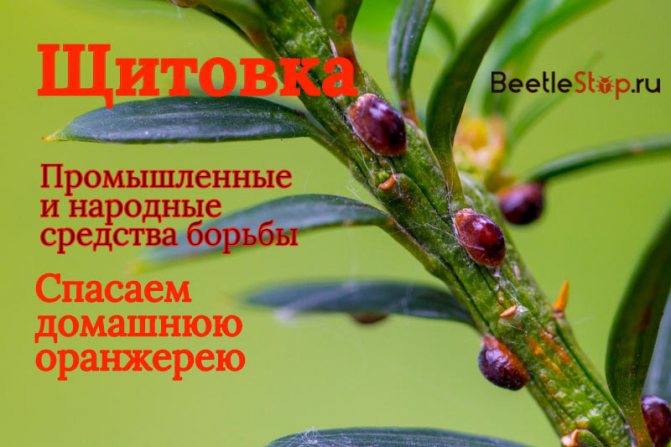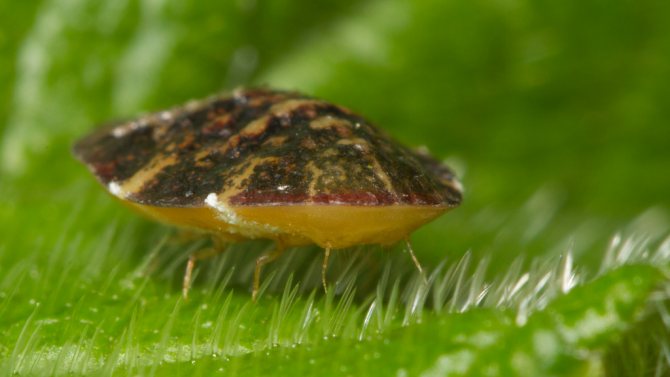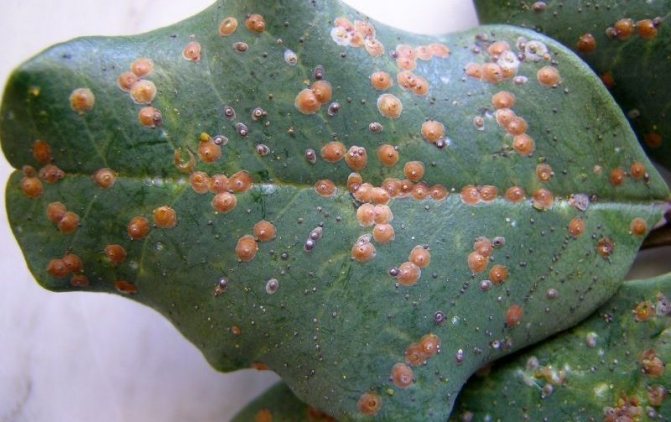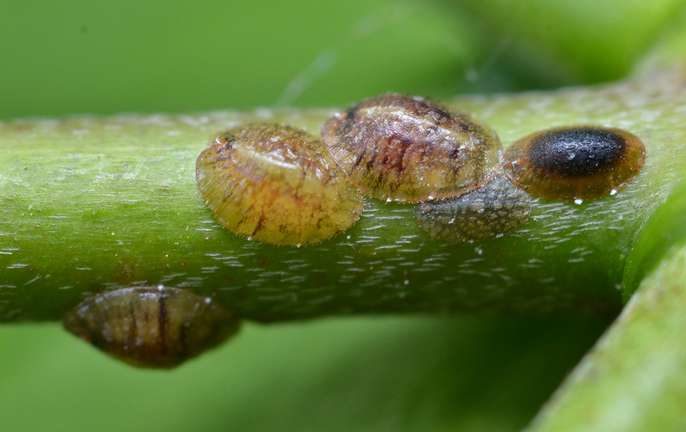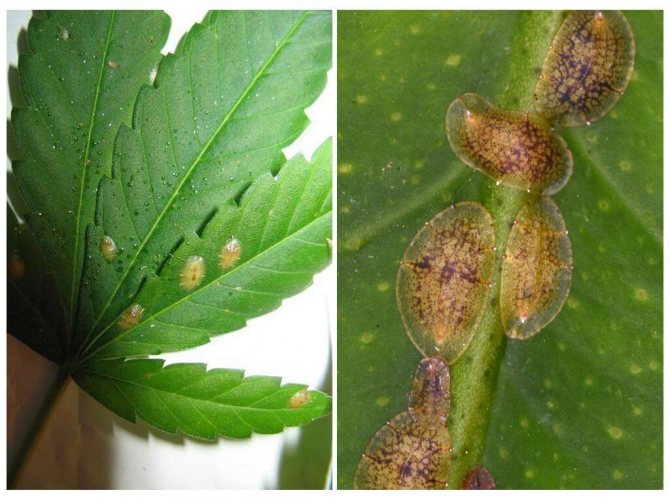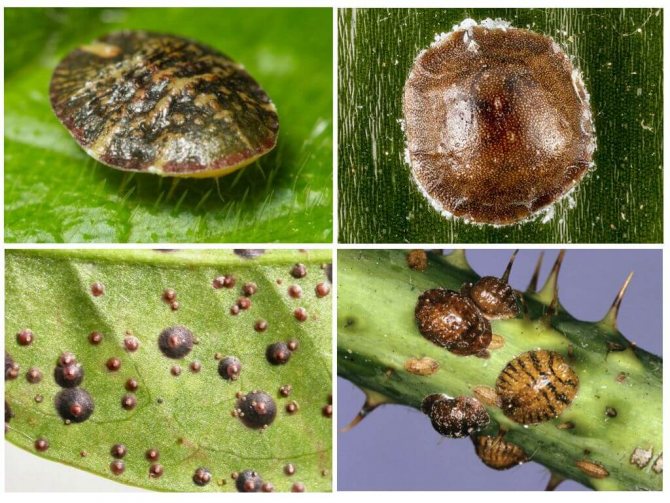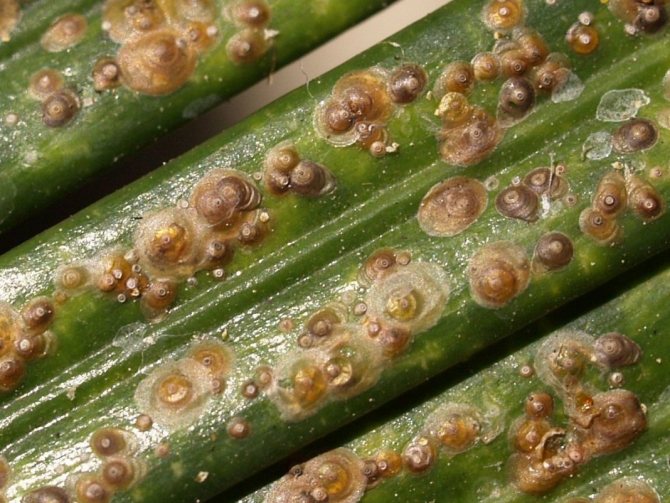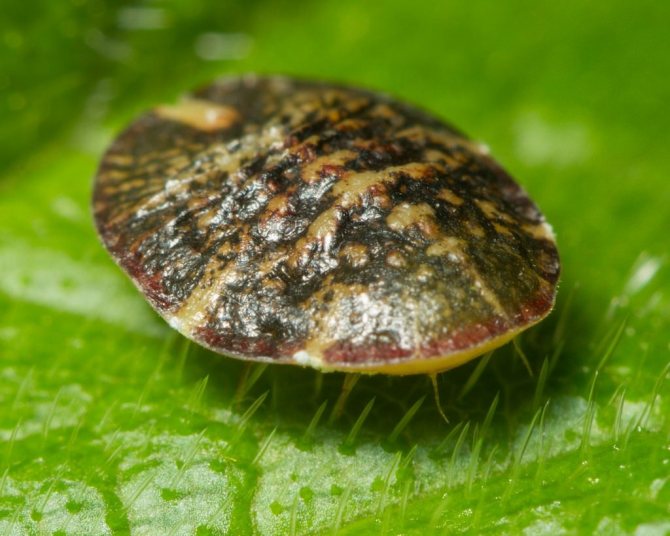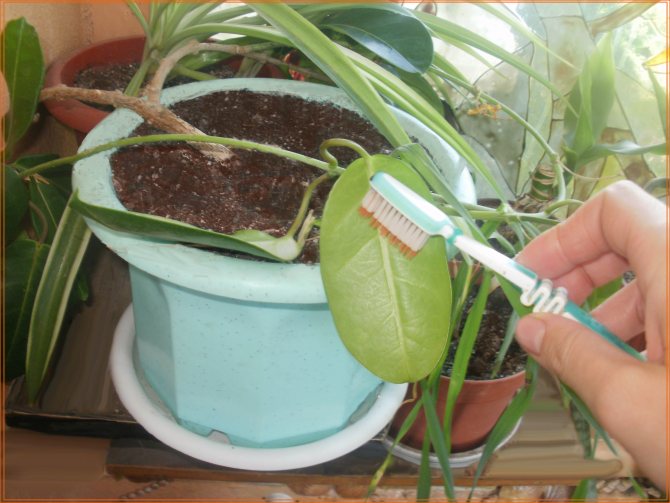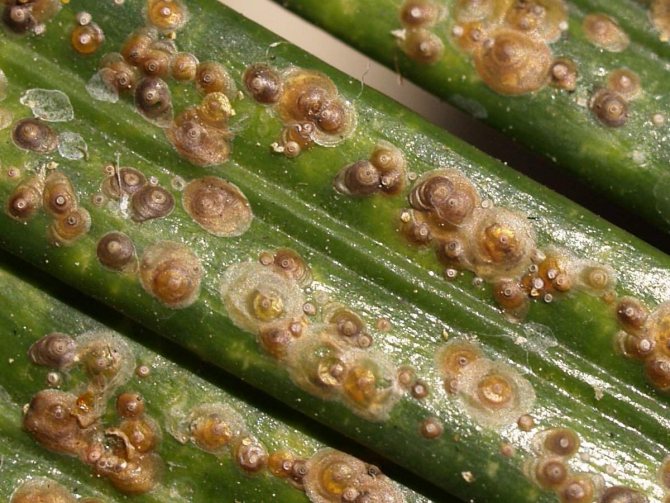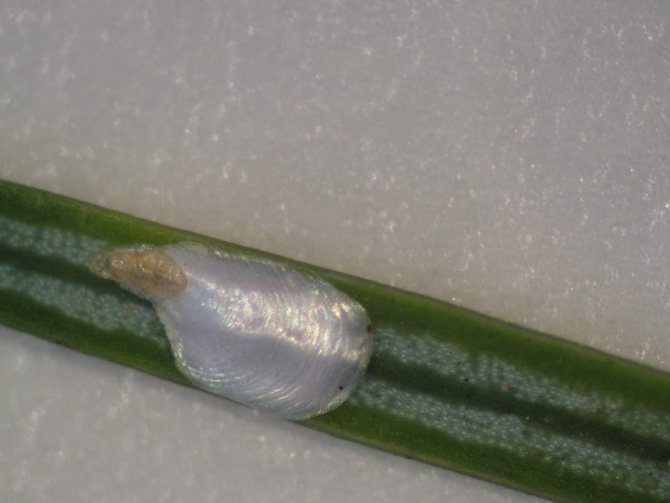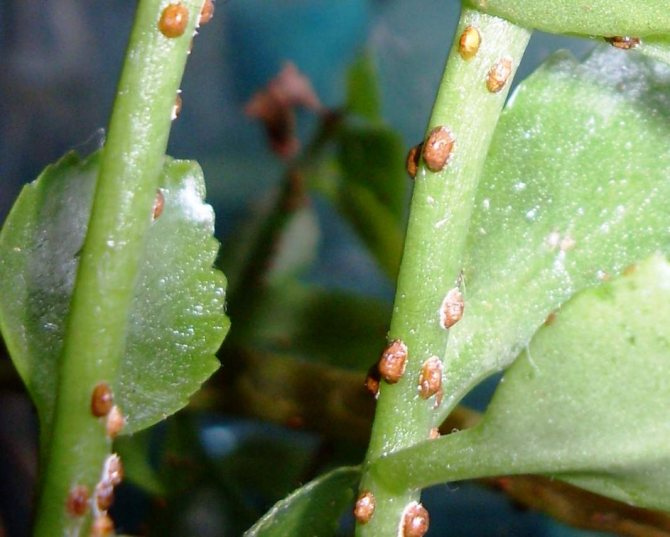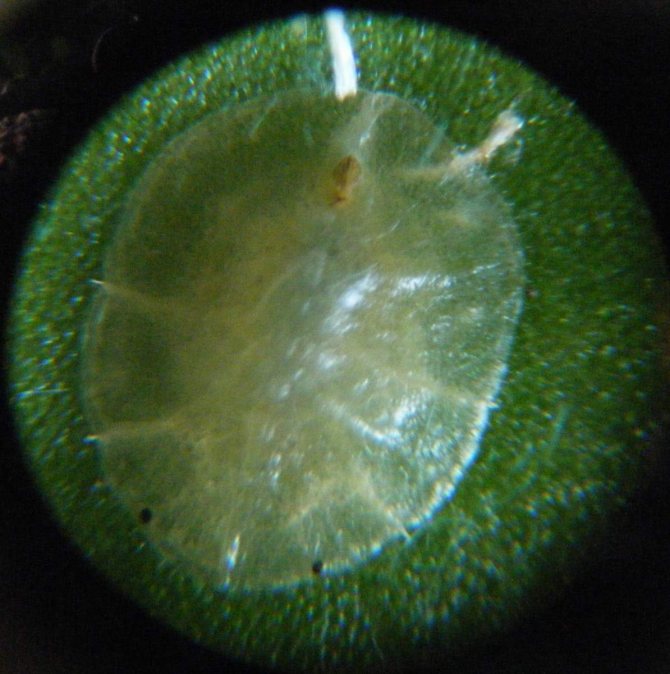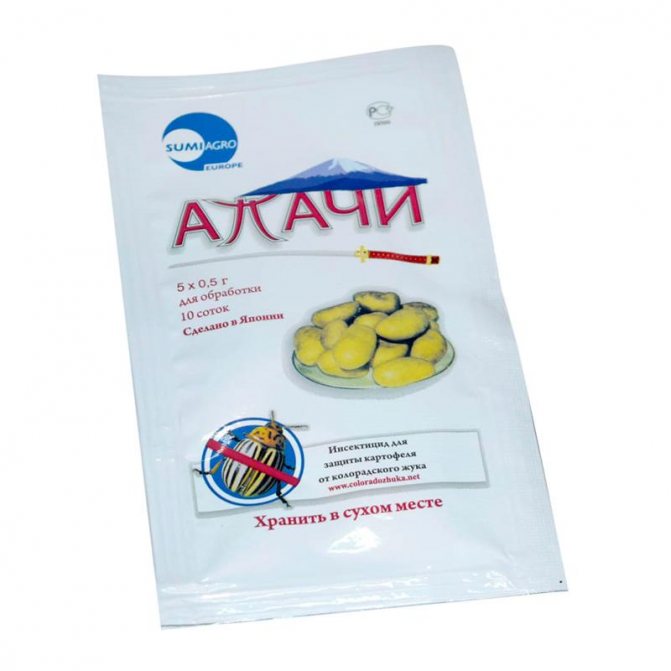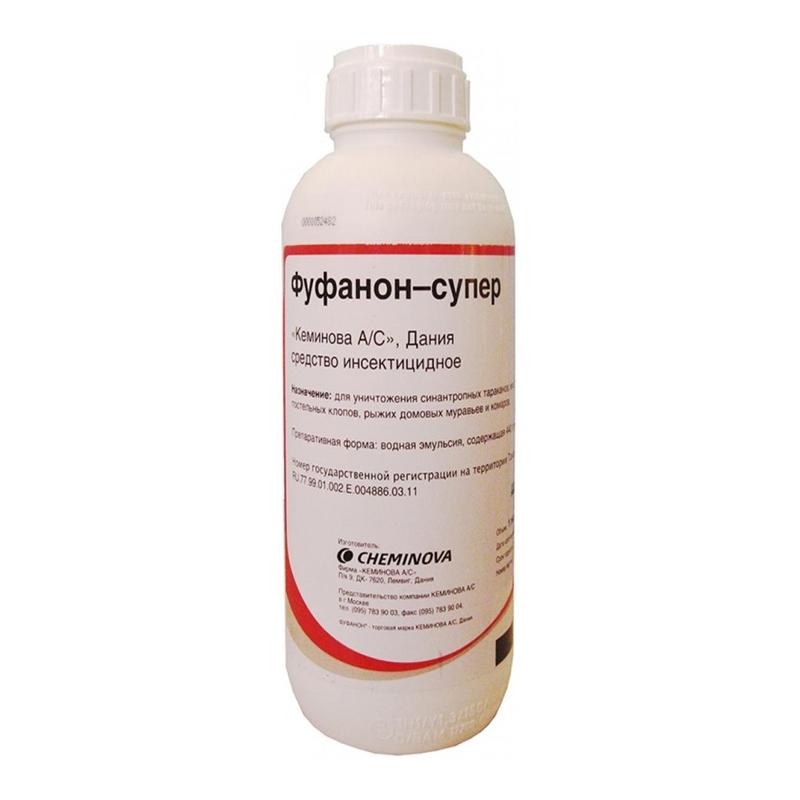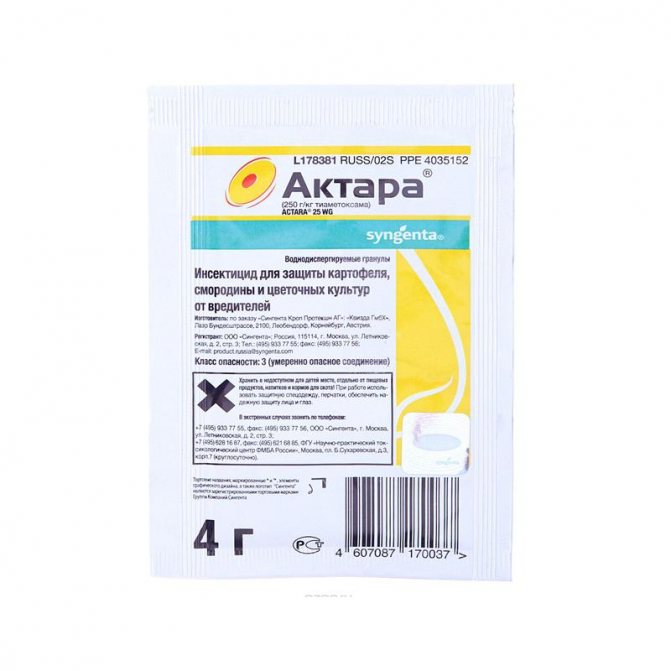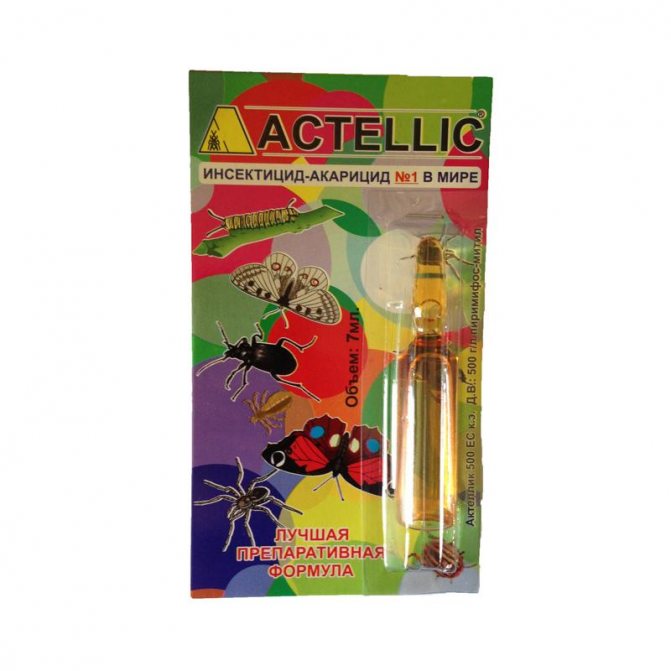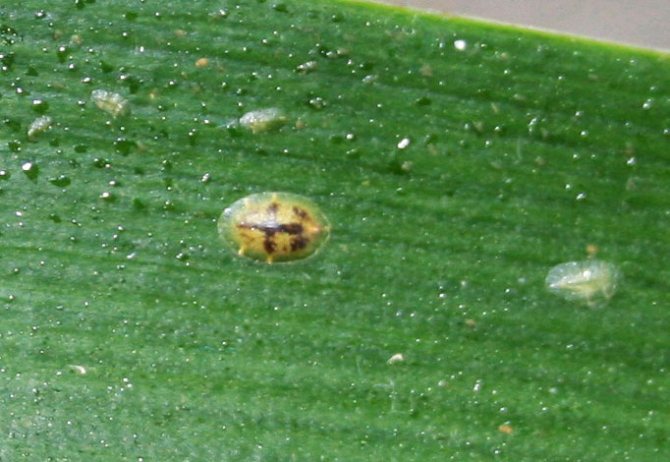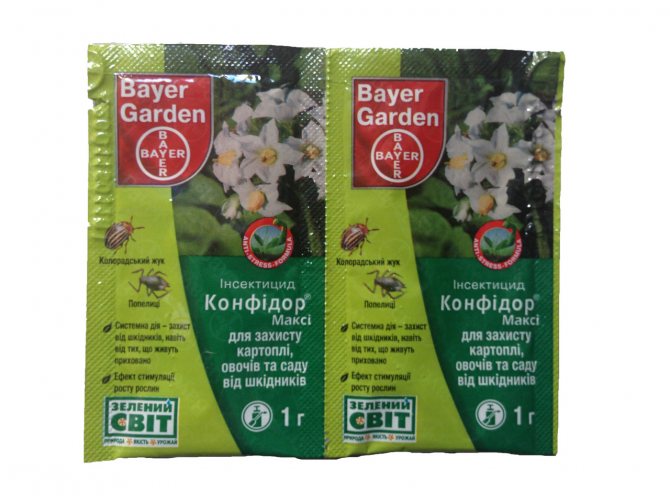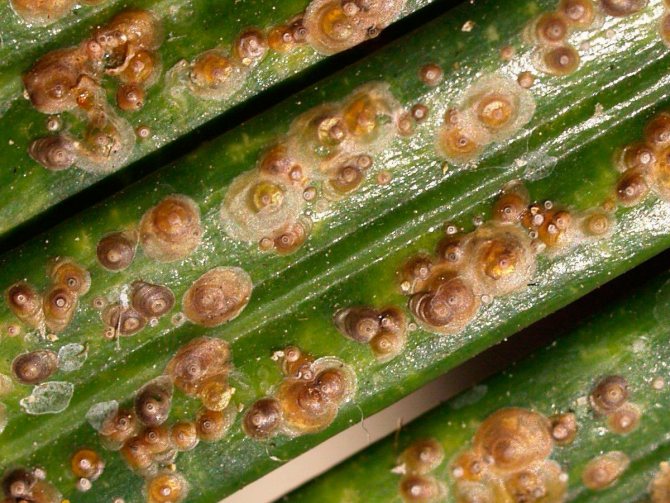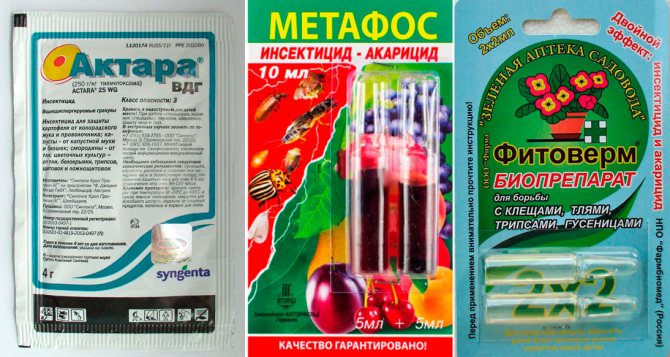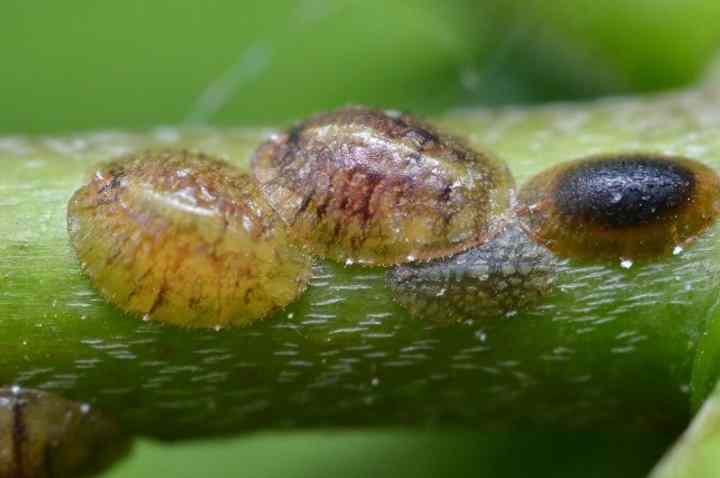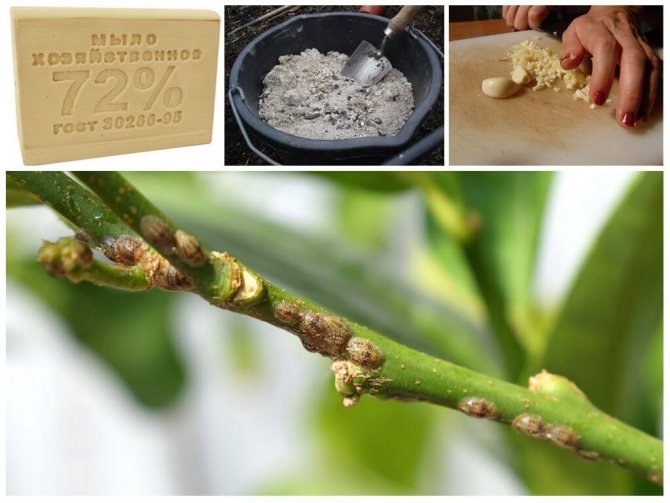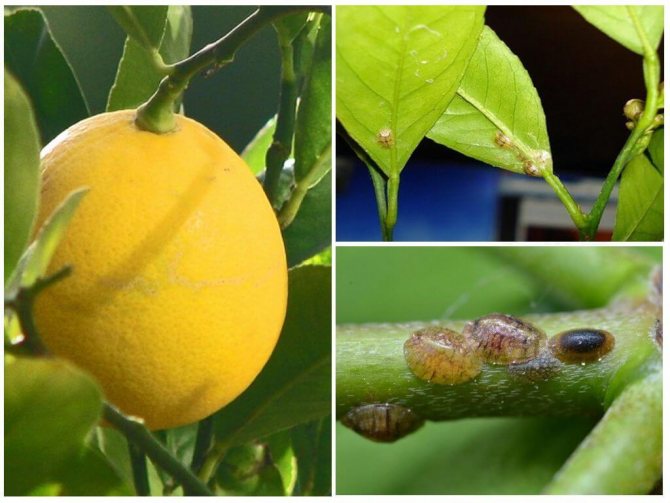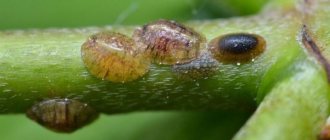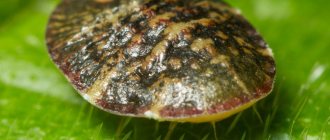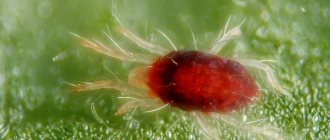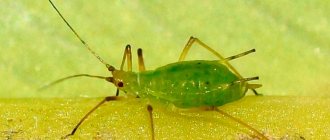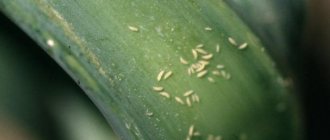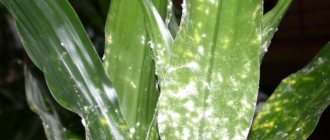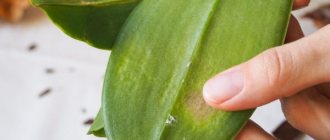The scale insect is one of the most dangerous pests that affect indoor plants. If the body of most dangerous pests is devoid of protection, then the scabbard is protected by a shell. In addition, she is able to quickly adapt to toxic substances. If the appearance of such pests on indoor flowers is noticed, you must immediately begin to fight them.
Many methods have been invented to help in the fight against this dangerous parasite. As a rule, the scabbard is destroyed mechanically, since the presence of a shell on it limits the use of toxic substances. Therefore, it is better to arm yourself with a number of recommendations so that the fight against the shield is successful.
What are scale insects and their biological characteristics?
A shield on indoor flowers is not uncommon. This is a fairly common type of parasite of the piercing-sucking type. Females have no wings, legs, antennae. In juveniles, the shield is soft. They are very active and can migrate in search of new food. Adults are motionless. The parasites are round in shape. Their body is 1.5 to 2 mm in size. The shield is dark brown. The body itself is yellowish. Females live for about 3-4 months.
Males, unlike females, have eyes. But that's not the whole difference. Males have shaped limbs and wings. Males can fly. They are orange or reddish in color. Males live for 3-4 days.
The eggs of the parasite are oval. Their size is 0.2 mm. The eggs are light gray in color.
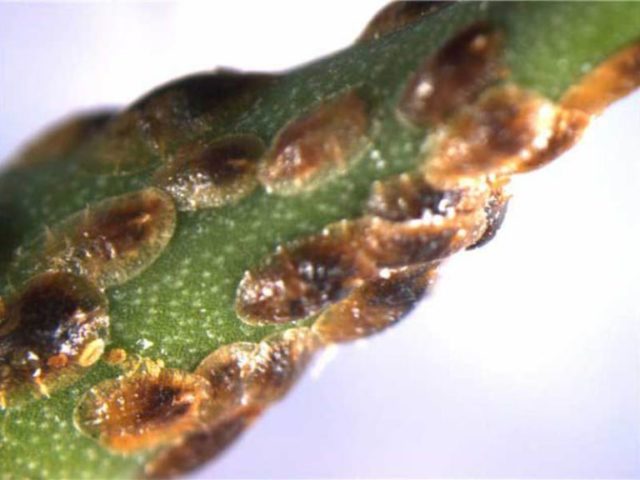
Scabbard on indoor flowers is not uncommon
How to recognize a pest?
Scabbards are insects no more than 5 mm in size. On their body there are numerous tentacles, with the help of which they are attached to the surface of leaves and stems. The covers are translucent and look like a wax plate. And if such individuals were found on indoor plants, it means that in front of you is none other than a scabbard - a pest, the fight against which is often quite difficult.
And the main difficulty in eliminating these parasites is that young individuals do not yet have a sticky shell, and therefore are able to freely move around the body of the plant and move to neighboring specimens. Plus, male scale insects have wings, thanks to which they can fly up to several meters. For these reasons, absolutely all flowers from your home collection should be processed. However, if adults are noticed quite simply, then their eggs are so miniature that it is very difficult to recognize them with the naked eye. In addition, females always lay their clutches on the underside of the leaf plates or in those places where the leaves are attached to the stem.
Sucking the juices from plants, scale insects deprive them of nutrients, as a result of which the flowers lose significant reserves of vitality. Affected specimens begin to fade gradually, their growth and development are inhibited. At this time, gluttonous parasites move to the foliage and continue to spoil the plant. Young shoots that have not yet managed to gain enough energy and strength are most affected by scabies. They die very quickly.
One colony of scale insects is capable of completely destroying an adult plant with a height of about half a meter in just two weeks. As a result of the invasion of parasites, only a bare dry stem will remain from a two-three-year-old flower. And you won't be able to save him.
On a note! When a plant loses 2/3 of its foliage, it cannot be reanimated!
Therefore, the home greenhouse must be regularly inspected and, if scabbards are found, immediately act, choosing the right methods of struggle.
Varieties of scale insects and false scales
There are more than 2000 species of scale insects. More often than others, the following types are found:
- Pear-shaped. Occurs on stone fruit plants.
- Orange. Citrus and laurel trees are striking.
- California. Found on pome plants.
- Pine. A favorite habitat is pine.
- Mulberry. Fruit and ornamental trees and shrubs are affected.
- Palm. It affects plants of palm origin.
The false shield does no less harm. It is very easy to recognize it. The shield of the false shield is attached to the body, and in the real shield, the shield is easily separated from the body. If there is a false scale on the leaves, branches, stems, then you will learn how to deal with it from our article.
Apple comma scale
These scale insects are also omnivorous. The apple comma-shaped scale is harmful to almost any fruit trees, especially apple trees. They also attack currants and walnuts.
An interesting fact is that only females settle on fruit trees, and bisexual scale insects are found on other crops.
Females are off-white in color, males have a red-gray body. Only eggs hibernate. The larvae get out of the scutellum when the apple trees begin to bloom.
Apple scale insects develop 2 times longer than mulberry scale insects; therefore, they have only one generation. The fertility of apple scale insects is 50-100 eggs.
Scabbard harm
Don't underestimate these little parasites. They are able to destroy not only a house plant, but also a whole bush, tree. In agrarian regions with a warm climate, if insects are found, quarantine is announced. It is forbidden to take out seedlings. All trees are treated with pesticides. Pests will destroy an indoor flower in a short time.
First, yellowish spots appear on the leaves. As the juice is sucked out, the spots grow. Leaves turn yellow, bend and fall off. The plant gradually withers and dies. If it is a fertile plant, then the ovaries fall off.
Parasites produce a special sticky liquid called pad. It is a delicacy for the fungus.
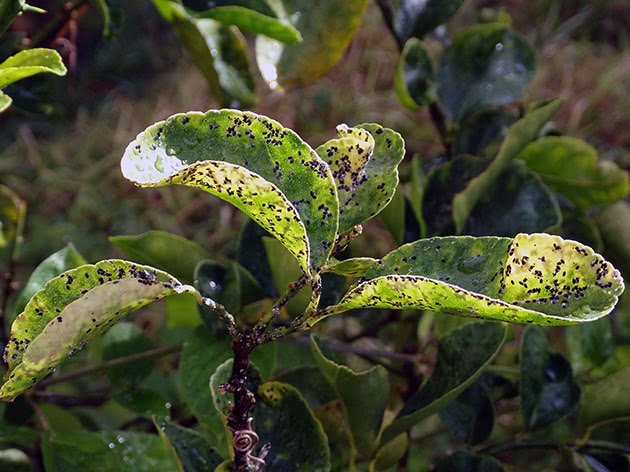

These little parasites shouldn't be underestimated
Signs of plant damage
Scabbards infect fruit trees, shrubs and ornamental house flowers. Insects damage bark, leaves, branches and fruits. Regardless of the type of parasite, it is quite easy to recognize a diseased plant.
Signs of defeat:
- flat round scales. At first, the scales are single up to 5 mm, but in advanced cases they grow and completely cover the leaf, stem;
- the affected surface becomes sticky;
- yellow spots that soon form holes;
- dry, curled and yellow leaves;
- cracked bark;
- premature fall of flowers and ovaries;
- curvature of branches;
- spots appear on the fruits;
- the plant gradually dries out.
If you find one or more signs, then the next question that should interest you is: what will help get rid of the scale insects on the flowers?


It is enough just to recognize a diseased plant
Factors that lead to plant infection
It is difficult to get rid of scale insects on domestic plants. In order to prevent their appearance, it is important to know why insects appear.
The reasons for their appearance lie in the wrong conditions for keeping the plant:
- lighting;
- dry / hot air;
- watering.
Pests do not attack healthy bushes and trees.Hence, we can conclude that plants that are weakened and overfed with nitrogen, which have impaired metabolism and insufficient protective forces to resist the pest, are affected.
The winter period is considered dangerous when there is not enough sunlight and too dry air. These are favorable conditions for the reproduction of parasites.
The scale insect can get home together with a new plant bought in a store. Adults are immobile, which cannot be said about young pests. Therefore, they are looking for new flowers in search of delicacies.


It is difficult to get rid of scale insects on indoor plants
What is this parasite
In total, there are several types of scale insects. Depending on which flower this dangerous pest was found on, one can assume which species it belongs to.
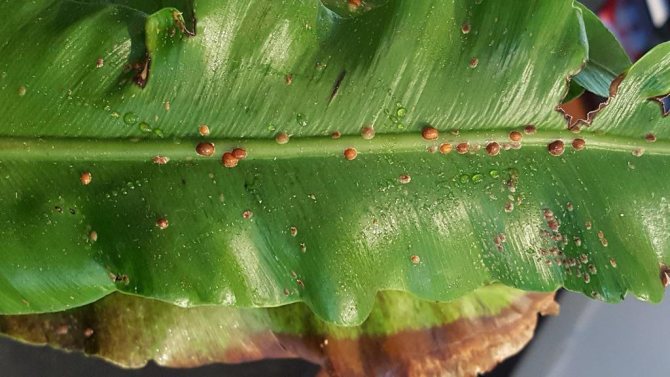

What does a scabbard look like on a plant
- cactus scale insects epiphytes;
- scaled brown prefers plants with succulent leaves, such as yucca, dracaena, Livingstone palm, rubber ficus, citrus fruits, oleander, camellia, and hibiscus;
- The scabbard usually affects olive trees, nightshades, pomegranate, bastard, laurel, and can also settle on hibiscus and citrus fruits.
Even the most attentive flower growers sometimes get lost, wondering where these parasites came from on well-groomed plants. In most cases, the scale insect larvae are brought into the house through open windows and vents. In addition, the appearance of insects is facilitated by the weakened immunity of the indoor flower (this phenomenon has two main reasons: inappropriate conditions of detention and an excess of vitamin supplements).
For your information! It is quite possible to remove the scabbard from plants with large and dense leaves. However, if the flower has small and delicate greens, then most likely it will not be possible to completely get rid of the pest.
Ways to fight
Adult scale insects have a strong chitinous shell, so most folk remedies do not work on them. They should be removed manually or sprayed with chemicals. You can fight the larvae and eggs of the pest with infusions based on pepper, garlic and onions.
It is not recommended to cleanse any fruiting plant with a chemical substance. In this case, the mechanical method is used. In case of severe damage, it is imperative to prune the dead branches and burn them.
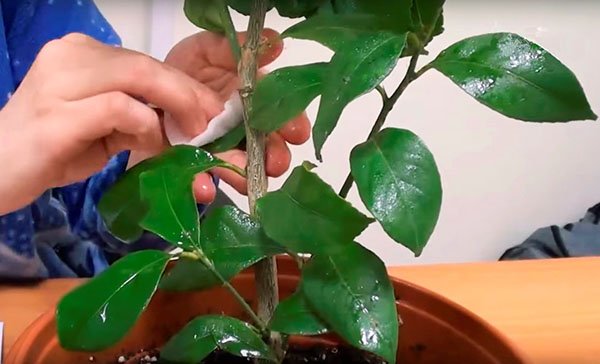

Most folk remedies do not work on scabbards.
Mechanical removal method
Is there a scabbard on the leaves of the plant? How to get rid of the parasite at home? The manual method is the most reliable, but laborious. To do this, you need a toothbrush, cotton pad, sponge. Soak an improvised product in a soapy, chemical solution and remove the parasite.
The difficulty of mechanical removal is that it is necessary to process all the leaves and twigs. The scabbard multiplies quickly enough, so if you missed at least one speck, then all the work done will be in vain.
How to get rid of scale insects on gardenia or any other plant with small delicate leaves? In this case, it is quite difficult to process the stems and leaves by hand. Get rid of large individuals using the above method, and tear off the leaves with small specks and discard.
How to deal with a scale insect on indoor plants
Removing the scabbard at home is not easy. The shell partially protects the insect from surface chemicals, small eggs and larvae are not visible to the naked eye. To save the flowers, you need to act quickly, use complex methods of dealing with the scabbard on indoor plants.
Mechanical cleaning
Regular removal of insects from a plant helps to reduce their number, but does not stop the development of the pest completely. The remaining eggs and larvae, as they develop, lead to repeated reproduction of insects.Mechanical cleaning is used as the first stage in the fight against the shield. The insect removal procedure includes three steps.
- Treatment. A concentrated solution of laundry soap is prepared. The soil is covered with polyethylene. A cotton pad is moistened in the solution, the whole plant is thoroughly wiped. Particular attention is paid to the underside of the leaves.
- Destruction. Moisten a thick rag, brush in soapy water, remove insects. You can use tweezers.
- Water procedures. The flower is placed in a bath, washed under running water to remove soap residues. The procedure is completely repeated weekly for a month to avoid repeated outbreaks of pest reproduction.
Chemicals
In case of mass defeat, it is better to purchase a special remedy for the scale insect on indoor plants. Flowers are sprayed or watered with insecticides. Insects receive a dose of toxic substances along with the sap of the plant and die. In the reviews, flower growers identify the most effective preparations for the scabbard:
- juvenoids and hormonal insecticides - "Admiral";
- neonictinoids - "Apache", "Corado", "Aktara", "Confidor", "Tanrek";
- phosphorus-containing preparations - "Kemifos", "Fufanon", "Actellik".
Insecticides are sold in the form of tablets, concentrates, and powder. The tool is diluted, used according to the instructions. One treatment is not enough - after a few days, watering or spraying is repeated.
Folk remedies
In the fight against the scabbard, folk remedies are often used. They are not toxic, but also less effective. The use of folk remedies is justified with a small number of insects. The most common recipes are listed below.
- Alcohol soap. Add a tablespoon of alcohol and liquid soap to a liter of hot water. The agent is stirred until foam appears, applied to the places of accumulation of scabbards. After an hour, the remnants of the product are washed off with running water.
- Oil and soap. Mix 10 g of machine oil and liquid soap, add 30 ml of water. Cover the soil in the pot with polyethylene. The mixture is distributed in places where scabs accumulate. After 12 hours, the flower is washed with running water.
- Laundry detergent with burdock oil. Add 10 g of washing powder and burdock oil to a liter of water, insist for four hours. The leaves are regularly wiped with a solution until the insects disappear completely.
- Wood ash. Add 300 g of ash to a liter of water, boil for half an hour. Before use, the broth is diluted in 10 liters of water. The soil is covered with polyethylene, the plant is sprayed with the agent.
- Pepper. Hot peppers are passed through a meat grinder. Add 100 g of pepper to 2 liters of water, insist for a day. Plants are sprayed with infusion at two-week intervals.
- Vinegar. After mechanical cleaning of the plant from pests, the stems and leaves are wiped with a weak solution of vinegar.
Folk remedies are more suitable for prevention. With a strong defeat, they are not effective enough. If there are a lot of scale insects, it is better to abandon traditional methods in favor of insecticides.
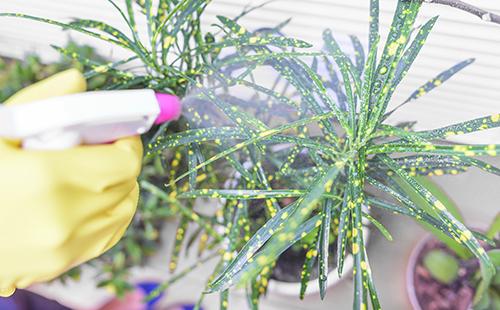

Chemical treatment
Fighting the parasite manually is not easy, so many growers prefer to destroy the pest with chemicals. It is not advisable to carry out such cleaning on fruiting plants.
It is recommended to use as a chemical:
- Intravir;
- Actellik;
- Aktara;
- Mospilan.
Before spraying the plant, you need to do some manual cleaning. Then prepare the solution according to the instructions, and treat first the aerial part, and then the plant itself. Remember to take precautions. Treat with a mask and gloves, as these drugs have a certain level of toxicity.
It is recommended to remove the top layer in the pot, because it can contain eggs and larvae of the parasite. Repeat the procedure after a couple of days.


You need to do manual cleaning before spraying the plant.
Folk ways of fighting
At home, several methods of pest control are used. For this purpose, improvised means are used. Is it possible to get rid of the scabbard with boiling water? If the plant is not severely affected, then this method is considered effective. Place the flower pot in the tub and turn on the hot shower. Scabbards are quickly washed off under the pressure of water. This procedure not only cleans the bush, but also hardens it. After bathing, treat the leaves with soapy water.
How to get rid of scale insects on anthurium? You can prepare a garlic-based solution. Chop 4 garlic cloves. Pour 200 ml of the resulting gruel. warm water. The solution should stand for 1-2 hours. Treat the leaves and stems of the anthurium. This method of struggle is used in the early stages. If the moment is already missed, then the garlic solution will be ineffective.
Prevention of the appearance
Scabbard on oleander, how to get rid of or scabbard on currants, how to get rid of these questions are often asked by experienced gardeners. The best preventive measure is regular inspection of the plant. You should inspect not only the inner surface of the leaf, but also the outer, as well as the stems, trunk and soil.
Prevention against scale insects is the same as for any other pest, be it an indoor flower or a tree in the garden. Weak shoots must be cut off in a timely manner. The cut site should be treated with garden varnish. In order to prevent the appearance of scale insects in the house, purchased new flowers must be isolated. The scale insect is an insidious parasite. It may appear after a week.
Avoid excessive soil moisture and moisture stagnation. Do not overfeed the plant. If the appearance of the parasite could not be avoided, then use chemical and folk remedies.
Preventive measures
There are many ways to remove the scale insect from indoor plants, but the best of them is to prevent its appearance at all. Of course, there are no one hundred percent ways to prevent the appearance of a pest, but there are rules that will help to significantly reduce the risk:
- Compliance with quarantine. Freshly bought flowers must be kept separately from others for at least a week, carefully observing their condition.
- Sterilization of the soil. Purchased or self-collected soil must first be disinfected: warm it up in the oven or process potassium permanganate solutions.
- Inspect the plants regularly. This is useful not only in the case of the scabbard: timely noticed signs of diseases or pests can help cure the flower, or even save it from impending death. It is especially important to carefully examine the leaves on both sides, as well as their axils and stem, because many parasites try to hide.
- Correct care. Ventilating and spraying the plants, choosing the right lighting and watering patterns can help prevent pests, as they prefer initially weak plants.
You can also give preference to plant varieties that are resistant to pests. Unfortunately, this cannot be considered a reliable method of prevention: it is not always possible to find suitable flowers, and insects are gradually adapting to new conditions.



